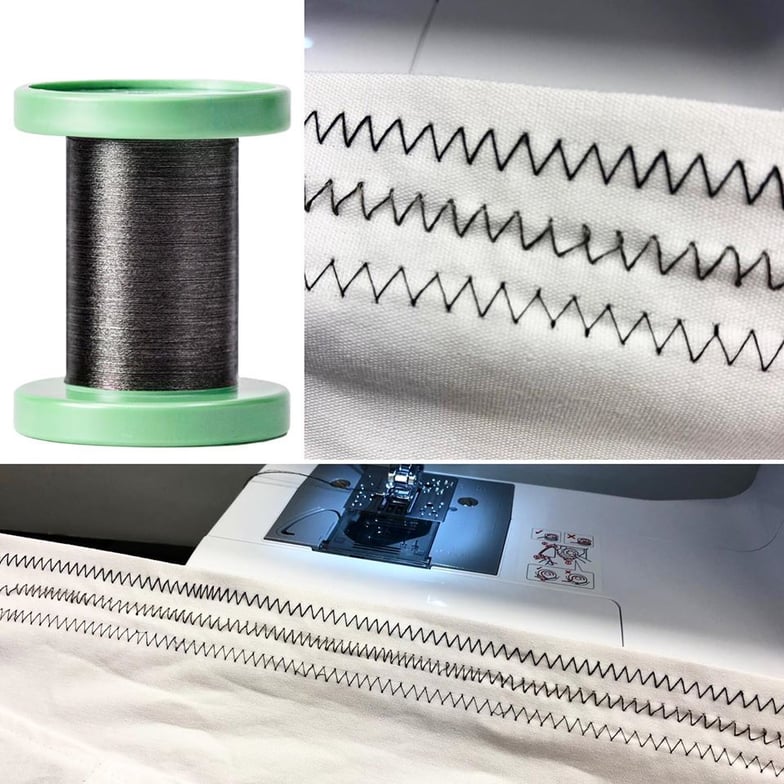
Our recent posts here in The Lab have highlighted several applications in which carbon nanotube materials could be used in the near future. This week we are continuing with that series by highlighting an application that we find particularly exciting: the use of electrically conductive carbon nanotube yarn (CNT yarn) in e-textiles.
The term “e-textile” refers generally to any fabric or piece of clothing that has some electrical function. Conductive threads that can be sewn into fabric or woven together are one of the main components of e-textiles and wearable electronics, although they are not the only thing that can be used: other methods for making e-textiles include printing patterns of conductive ink onto conventional textile fabric or adhering larger electronic components to clothing using pins or adhesives. We have demonstrated the use of DexMat CNT yarn in simple e-textile projects in a few of our past blog entries. In this post, we want to provide a quick run-down of the various types of conductive thread that are being used today, and discuss how CNT yarn compares to those materials.
Conductive Polymers
A few polymers have the intrinsic ability to conduct electricity. The flexibility of polymer materials and their ability to be processed in solution make these materials extremely useful for creating flexible electronic components of various shapes, including conductive thread. For wearable e-textile applications, conventional textile thread like silk can be coated with a conductive polymer layer in order to gain some electrically conductivity while keeping the strength and flexibility of the underlying thread. Conductive polymers can be mixed with various other materials or dopants to optimize them for particular applications and can be made into semiconductors as well as conductors. One of the primary drawbacks of these materials is that their conductivity is typically much lower than that of metals, although sufficient alignment and doping can increase it to a level that exceeds stainless steel, as in the case of stretch-oriented polyacetylene.
Metal-Coated Textile Threads
Another way to make a hybrid conductive thread is to coat a textile thread or flexible polymer thread with a layer of metal, such as nickel or silver. This produces threads that have a highly conductive outer skin, but still retain the strength, flexibility, and approximate density of the underlying thread. As an additional benefit, the metallic skin of these threads allows them to be soldered to other metallic parts in order to form a good electrical connection. Durability can be an issue for these threads, however, as the metallic layers can de-bond and begin to peel away from the textile substrate. This creates a challenge for articles of wearable clothing, since long-term wear or laundering in a washing machine could lead to degradation of the thread.
Stainless Steel Thread
Stranded stainless steel yarns perform well as conductive threads due to their high strength and durability; steel is durable enough to be worked into thin, flexible filaments without breaking. This is also an option that provides very good conductivity compared to insulating textiles with metallic coatings, because in this case the entire thread is made of conductive metal; a stranded thread made of pure copper or silver might provide more conductivity, but would be far less durable. Stainless steel is also more resistant to oxidation than silver, and has been shown to stand up to washing better than silver-coated textiles. The drawbacks of this option are its weight and stiffness.

Carbon Nanotube Yarns
Hybrid conductive threads, in which textile thread is coated with conductive polymer or with a metal layer, exist to preserve the mechanical properties and light weight of conventional thread for maximum comfort and ease of construction in wearable e-textiles. Stainless steel thread exists to maximize achievable conductivity while avoiding corrosion. In terms of material properties, CNT yarn offers the best of both worlds. From a mechanical standpoint, CNT yarns are more similar to textile fibers than to metal wire: they have excellent tensile strength, flexibility, and fatigue life, and they are lightweight. At the same time, CNT yarn has a conductivity that is similar to metals, exceeding that of stainless steel thread. While silver and nickel have higher conductivity than CNT yarn, they are typically incorporated into conductive thread in the form of a thin coating over an insulating filament core, resulting in a lower overall conductivity. Finally, CNT yarn is even more resistant to oxidation than stainless steel, so it should be able to maintain its properties and durability through laundering and daily use.
Instead of using a pure CNT yarn, it is also possible to use CNTs to create hybrid conductive threads. One way to do this is by depositing a layer of CNTs onto the outside of other fibers to add conductivity; this can be helpful if the goal is to more closely match the properties of a particular underlying fiber. This line of products is an example of this technology in action. Alternately, CNT yarns can themselves be coated with layers of metal. This process can enhance their conductivity further, but just as importantly it improves their ability to be soldered onto other electrical parts or threads.
The primary drawback of CNT yarns compared to other conductive threads is their cost, which is significantly higher than that of the alternatives at this time. This may keep CNT yarn from becoming competitive for most e-textile applications until the price of raw CNTs and processed CNT materials can be decreased. On the other hand, it is possible that CNT yarn could appear sooner in applications which require very high performance conductive thread.
If you have an e-textile or wearable electronics application and are interested in trying out our CNT yarn, you can find it for sale on our store at the link below!
